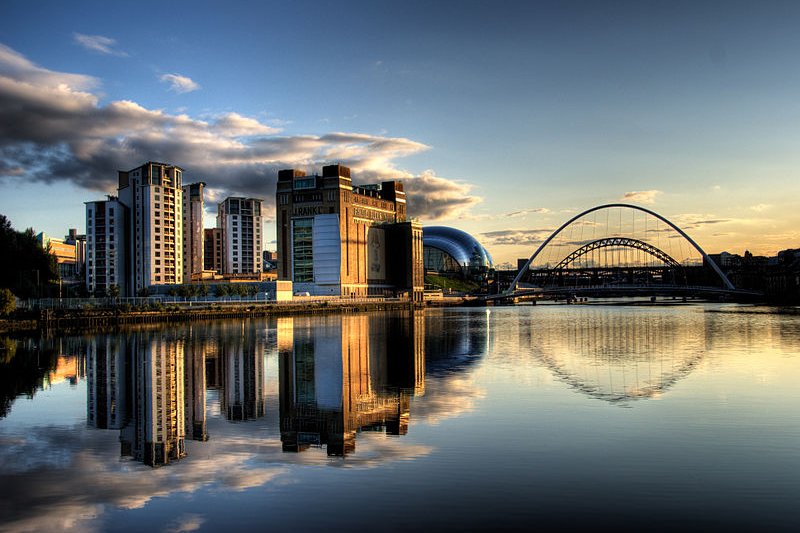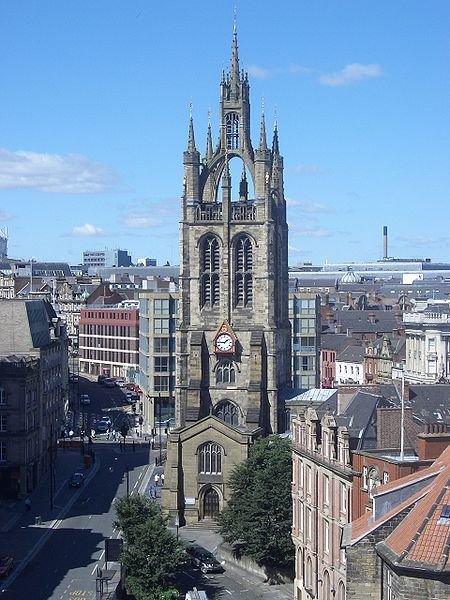 View of the Newcastle upon Tyne Quayside: Source: https://commons.wikimedia.org/wiki/File:Newcastle_Quayside_with_bridges.jpg
View of the Newcastle upon Tyne Quayside: Source: https://commons.wikimedia.org/wiki/File:Newcastle_Quayside_with_bridges.jpgAuthor: Wilka Hudson

Newcastle upon Tyne, often known simply as Newcastle, is a city in Tyne and Wear, in North East England. It covers 113 sq km (43.6 sq mi) and has a population of 292,000 people (2012 estimate). It is the 16th most populous city in the United Kingdom.
Newcastle is located on the northern bank of the River Tyne. Its history goes back to Roman times, when the Romans built a fort and bridge on the River Tyne. It was named Pons Aelius after the Roman Emperor Hadrian. When the Romans left in AD 410, Newcastle was absorbed into the Anglo-Saxon kingdom of Northumbria. During this period it was called Monkchester.
 Street in Newcastle upon Tyne, with Tyne Bridge in the background: Source: https://commons.wikimedia.org/wiki/File:Side_-_Tyne_Bridge.jpg
Street in Newcastle upon Tyne, with Tyne Bridge in the background: Source: https://commons.wikimedia.org/wiki/File:Side_-_Tyne_Bridge.jpgAuthor: SilkTork

The name Newcastle dates back to the Norman Conquest, when William the Conqueror built a wooden castle here in 1080, and from then on, the town was called Novum Castellum, or New Castle.
Newcastle prospered during the Industrial Revolution. During the 18th century, it was the fourth largest printing center in England after London, Oxford and Cambridge. It was also a center for the production of flint glass.
 Earl Grey Monument, Newcastle: Source: https://commons.wikimedia.org/wiki/File:Earl_Grey_Monument,_Newcastle_-_geograph.org.uk_-_974047.jpg
Earl Grey Monument, Newcastle: Source: https://commons.wikimedia.org/wiki/File:Earl_Grey_Monument,_Newcastle_-_geograph.org.uk_-_974047.jpgAuthor: John Salmon
 From the 16th to the early 20th century, Newcastle developed into one of the largest shipbuilding centers in the world. The shipyard industry has since been in decline. It suffered from massive unemployment in the Great Depression of the 1930s. The suffering continued for much of the 20th century, as the city's coalpits closed, followed by its shipyards, right up to the 1990s.
From the 16th to the early 20th century, Newcastle developed into one of the largest shipbuilding centers in the world. The shipyard industry has since been in decline. It suffered from massive unemployment in the Great Depression of the 1930s. The suffering continued for much of the 20th century, as the city's coalpits closed, followed by its shipyards, right up to the 1990s.Newcastle today is since shifted its attention, becoming a business and cultural center with a vibrant nightlife. Urban redevelopment of the Newcastle Quayside has turned it into an entertainment precinct with a number of bold structures, including the Gateshead Millennium Bridge and The Sage Gateshead music venue.
 St Mary's Roman Catholic Cathedral, Newcastle: Source: https://commons.wikimedia.org/wiki/File:St._Marys,_Newcastle.jpg
St Mary's Roman Catholic Cathedral, Newcastle: Source: https://commons.wikimedia.org/wiki/File:St._Marys,_Newcastle.jpgAuthor: Kage ca

Visiting Newcastle upon Tyne
The Newcastle International Airport (NCL) receives flights from Aberdeen, Alicante, Barcelona, Belfast, Bergen, Birmingham, Bristol, Brussels, Cardiff, Düsseldorf, Exeter, Faro, Isle of Man, Jersey, London-Gatwick, London-Heathrow, Málaga, Malta, Paris, Southampton and Stavanger, among others.You can take trains of the East Coast Line from London and Edinburgh to Newcastle. Trains of the Cross Country Line connects it with Birmingham, Leeds and Sheffield. The Transpennine Express train services connects Newcastle with Leeds, Manchester and Manchester Airport.
To reach Newcastle by car from London, take the M1 motorway, which continues at certain stretches as the A1 highway, and as the A1(M) motorway on approaching Newcastle.
 St Nicholas Cathedral, Newcastle: Source: https://commons.wikimedia.org/wiki/File:Newcastle_upon_Tyne,_England.jpg
St Nicholas Cathedral, Newcastle: Source: https://commons.wikimedia.org/wiki/File:Newcastle_upon_Tyne,_England.jpgAuthor: Soloist

- Angel of the North: Modern sculpture by Antony Gormley, a short distance from Newcastle.
- Castle Keep: Remains of the castle that gives Newcastle its name.
- Gateshead: City on the south bank of the River Tyne, directly across from Newcastle.
- Gateshead Millennium Bridge: A pedestrian and cyclist tilt bridge completed in 2011.
- Grainger Town: The historic heart of Newcastle surrounding by some of the finest buildings of the city.
- Great North Museum: Museum holding a diverse collection of artifacts ranging from fossils and mummies to displays of local history.
- Grey's Monument: Monument to Charles Grey, 2nd Earl Grey, built in 1838.
- Hadrian's Wall: Remanant of the ancient Roman wall can be seen to the west of the city.
- River Tyne: The river on which Newcastle is located has been cleaned up, with pedestrian promenades built on the quayside. This is a good place to enjoy views of Newcastle.
- Segedunum: Archaeological site preserving the remains of the fort built by the Romans.
- St Nicholas Cathedral: Anglican cathedral, one of the three cathedrals in Newcastle, the other two being the Roman Catholic St Mary's Cathedral and the Coptic Cathedral.
- Tyne Bridge: Built in 1928, this suspended-deck arch bridge looks a lot like the Sydney Harbour Bridge, which was completed four years later.
Newcastle upon Tyne is  on the Map of cities in England
on the Map of cities in England
 Latest updates on Penang Travel Tips
Latest updates on Penang Travel Tips
Map of Ceremonial Counties of England

Copyright © 2003-2025 Timothy Tye. All Rights Reserved.

 Go Back
Go Back